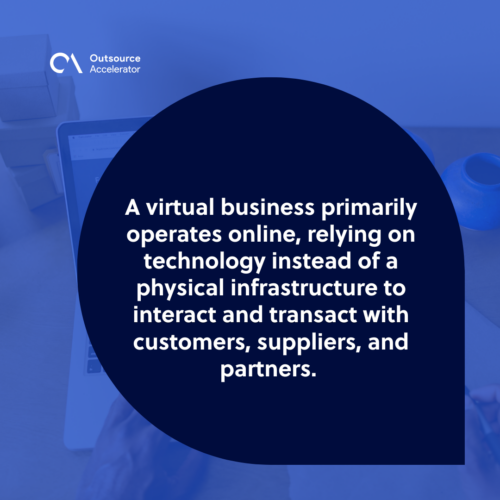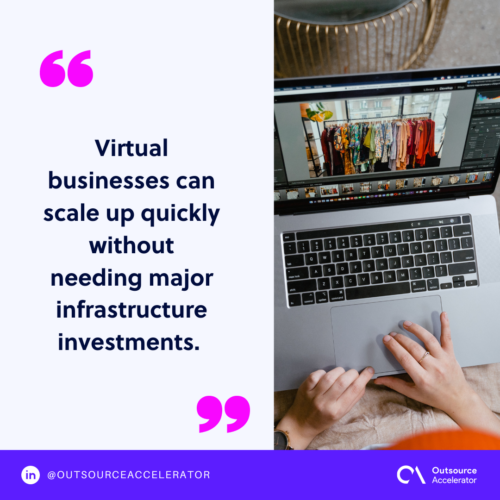Virtual business: The path to sustainable growth

Companies today embrace virtual business for long-term growth because of cost-efficiency, flexibility, and global reach through technology and remote work.
So, what’s the deal with virtual business? This article will explore virtual business, its benefits, challenges, and future outlook.
Definition of virtual business
A virtual business primarily operates online, relying on technology instead of a physical infrastructure to interact and transact with customers, suppliers, and partners.
It often involves:
- E-commerce
- Digital marketing
- Remote collaboration
- Virtual customer support
These elements allow companies to reach a global audience and operate without the constraints of a physical location.
Virtual business is a modern approach gaining popularity due to its advantages and growth potential.

Advantages of virtual business
A virtual business provides several benefits that have become increasingly evident in the current digital era. Here are some of the notable ones:
Cost-effectiveness
Virtual businesses are more cost-efficient than traditional ones.
For one, firms can save money by not needing large office spaces. Their savings can be invested in marketing, product improvement, or skilled employees.
For instance, consider virtual banks, often called “core banking” institutions. They’ve shaken up the regular banking sector by delivering services without physical branches.
This efficient approach lets them offer affordable banking choices, reducing customer fees and improving business profits.
Flexibility and work-life balance
Virtual businesses provide flexibility to employees and owners. Remote work allows people to work from anywhere, achieving a better work-life balance.
In particular, a virtual banking team might have members in various time zones, enabling them to offer customer support around the clock.
This flexibility boosts productivity and also increases employee happiness and retention.
Global reach and customer base
Virtual businesses can tap into global markets and connect with diverse customers. Since the internet is more connected and accessible, geographical barriers are no longer big problems for virtual businesses.
Consider the case of a virtual bank providing online services. They can attract customers worldwide without needing physical branches.
This not only broadens the potential customer reach but also boosts the company’s competitiveness on a global level.
Scalability and growth potential
Virtual businesses can scale up quickly without needing major infrastructure investments.
They can effortlessly bring in new employees as they grow, establish remote teams, and use technology to automate tasks.
Imagine a virtual banking platform dealing with a surge in demand. It can quickly grow by increasing server capacity and hiring more customer support staff.
This agility empowers virtual businesses to adjust and expand smoothly.

Challenges and solutions in virtual business
Despite its many benefits, a virtual business also comes with challenges. Organizations need to tackle these obstacles to ensure smooth operations and sustained success:
Communication and collaboration
A significant hindrance for virtual businesses is establishing efficient communication and teamwork among team members scattered across the globe.
Nonetheless, technological progress has brought about solutions to address these issues.
To encourage smooth communication, virtual businesses can use collaboration tools like:
- Project management software
- Video conferencing platforms
- Instant messaging apps
Virtual teams can overcome geographical obstacles and collaborate effectively by using these tools.
Security and data protection
As digital platforms become more integral, virtual businesses encounter ongoing risks like cybersecurity breaches and data theft.
Effective security measures and data protection protocols can tackle these issues and uphold the safety of sensitive information.
For instance, virtual banks use advanced encryption technologies to shield customer data and ensure secure online transactions. These security steps safeguard the business and its customers and cultivate user trust and loyalty.
Workforce management and productivity
Supervising a virtual workforce presents distinct difficulties. Owners must guarantee that employees stay motivated, involved, and efficient while working remotely.
Still, these obstacles can be conquered with effective approaches.
Virtual businesses can enforce remote work guidelines, set up definite performance standards, and offer frequent input to maintain employee productivity.
Also, using productivity tools and project management software can boost efficiency and confirm successful task completion.
Future of virtual business
Virtual business model has firmly established itself and holds even more promise in the future.
The following factors will shape the path of virtual businesses and greatly impact organizations globally:
Technological advancements
The future of the virtual business model looks promising, driven by continuous technological advancement that enhances connectivity and efficiency.
Innovations such as artificial intelligence, machine learning, and blockchain technology are poised to revolutionize virtual businesses’ functions.
Consider virtual banks investigating AI-powered chatbots to deliver tailored customer service.
These chatbots manage routine queries, allowing human employees to concentrate on more intricate assignments. Utilizing chatbots can enhance customer satisfaction and bolster operational efficiency.
Remote work culture
With the rise of virtual business practices, remote work is becoming more popular.
Workers now desire adaptable work setups that allow them to work from anywhere. This helps achieve a better balance between work and personal life and increases job satisfaction.
Virtual businesses that promote a remote work culture gain an edge in attracting top talent worldwide.
Businesses can build diverse and highly skilled teams by accessing a global pool of skilled professionals, driving their growth and achievements even more.

Sustainability and environmental impact
Virtual businesses can significantly reduce environmental impact compared to traditional brick-and-mortar setups.
They achieve this by reducing physical infrastructure, promoting remote work, contributing to sustainability efforts, and reducing greenhouse gas emissions.
For example, a virtual bank eliminates the need for customers to travel to a physical branch, reducing carbon emissions from transportation.
Reduced paper and physical resources also contribute to a more sustainable future.
Embracing virtual business for competitive advantage
Embracing virtual business opens the door to various chances for companies to gain a competitive edge. Businesses can uncover fresh possibilities, extend their influence, and realize lasting success by:
- Using technology effectively
- Prioritizing cost-effectiveness
- Adopting a remote work culture
Virtual businesses can shine in a saturated market by showcasing their expertise and staying ahead of technological progress.
It goes beyond a trend – it’s a strategic approach that empowers companies to adjust and thrive in an ever-evolving business environment.
To sum up, a virtual business signifies the future of sustainable growth.







 Independent
Independent




